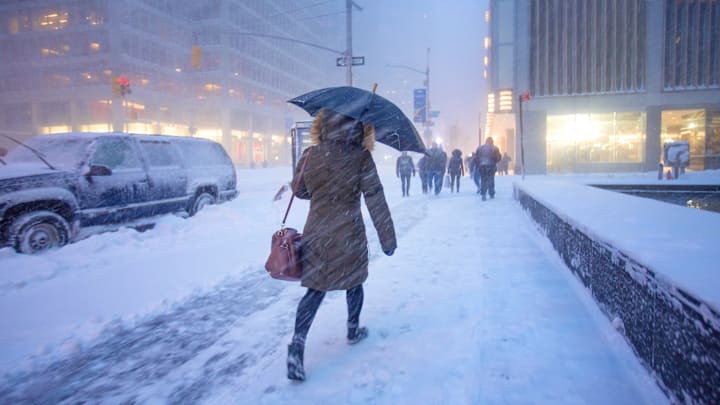Parts of the northeastern United States are looking at a ginormous amount of snowfall this week—particularly western New York, which could see "multiple feet" of lake effect snow. The forecasts are being accompanied by an unusual buzzword: thundersnow. Thundersnow occurs during a thunderstorm that produces snow instead of rain. The mechanisms that produce rainy thunderstorms and snowy thunderstorms are largely the same, even if the air temperature is below freezing.
A band of snow can become strong enough to produce lightning through two processes known as convection and forcing. Convection occurs when an area of warm air quickly rises through cooler air above it. Convective snow is most common during lake effect snow events like those you’d find on Lake Ontario or Lake Erie, since the process requires extreme vertical temperature gradients that can result from bitterly cold air flowing over a warm body of water.
Forcing is slightly different. A strengthening low-pressure system involves fast, dynamic changes in the atmosphere, especially when one of these storm systems quickly gains strength. Such a fast-developing storm can cause large amounts of lift in the atmosphere, a process that forces air to swiftly rise like you’d see during convection. This creates intense bands of snow that can grow so strong that they produce thunder and lightning. This process is responsible for the thundersnow that occurs during blizzards and nor’easters, those powerful storms that regularly hit the eastern coast of the U.S. during the winter. Thundersnow can be pretty exciting—just ask The Weather Channel's Jim Cantore:
The name “thundersnow” can be a bit misleading. One of the most enjoyable things about a snowfall is how silent it is outside when there’s a thick blanket of snow on the ground. Snow absorbs sound waves so efficiently that you can usually only hear ambient noises immediately around where you’re standing. Snow muffles the sound of thunder for the same reason. Thunder that might be audible for many miles during a rainy thunderstorm might only be audible for a few thousand feet away from where the lightning struck. Unless the lightning strikes very close to where you are, you might only see a bright flash during thundersnow without ever hearing the thunder.
While thundersnow is a fascinating phenomenon to encounter, it does involve lightning, after all, and it’s just as dangerous as any other lightning bolt you’d see in a rainy thunderstorm. If you’re ever lucky enough to experience thundersnow, the event is best enjoyed indoors and out of harm’s way.
This piece originally ran in 2017.
